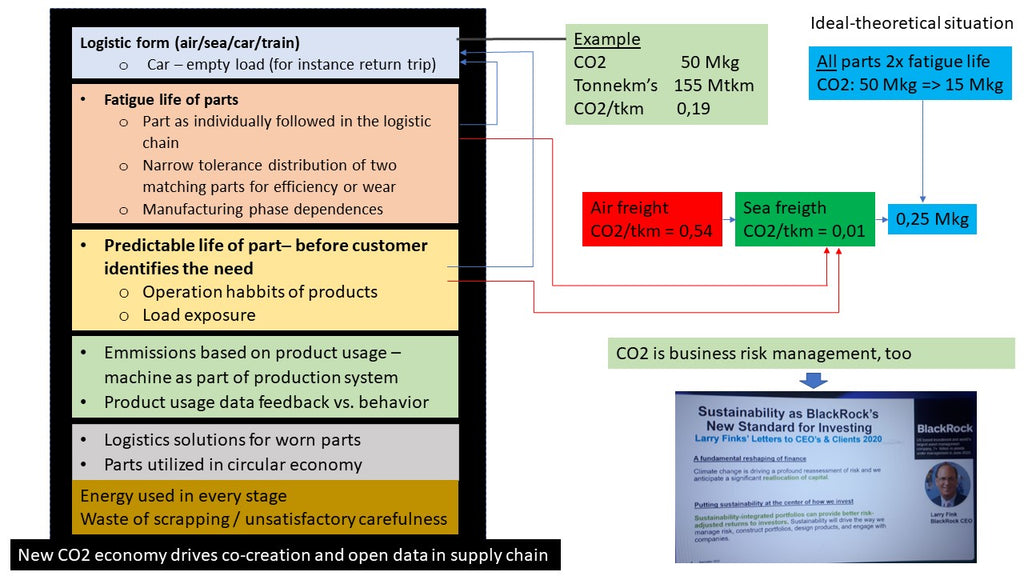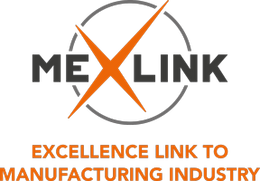CO2 and manufacturing
Julkaisi PASI JULKUNEN /

How Sustainability driver (amplified by digitalization) will change manufacturing as well as business logic?
Digitalization as buzzword has been heart in too many contexts and that has reduced its real value. As buzzword, digitalization is used disconnected from the big picture. Nevertheless, it still remains one of the grand drivers in business. The other raising topic, sustainability and CO2, might be even bigger than digitalization. In fact, CO2 drives new business logic with digitalization.
What are the main components of CO2 in the context of manufacturing industry? Let’s look at the case of outbound logistics (values are changed a bit but in right balance, and the case is simplified).
Transport is the obvious source for CO2, but how to influence it. Typically, need to deliver a spare part was “yesterday”, so it will be delivered the fastest way by air. Other sources would be less CO2 consuming like sea freight. Let’s start to simulate the case of outbound logistics by influencing Tonnekilometers (Tkm). One way to decrease traffic is to increase spare parts’ lifetime double. Theoretically if life time of all pieces would be double, annual Tkm’s will drop to half and CO2 emissions will drop from 50 Mkg to 15 Mkg. If we make a bit of violence to the real case and assume that all has been delivered by air freight. Then we change the rest to sea freight again forgetting, that we need to deliver the parts to the customer premises inland from harbour. The CO2 in harbor will drop up to 0,25 Mkg. The example just provides direction in long term. It is unrealistic to expect ideal situation. However, this will demonstrate that reliability scientifically a boring issue will raise to core topic in the future.

However, change has cultural obstacles. We are used to rapid changes, chase cost reduction and reduce networking capital. Slow transport by see probably requires increasing networking capital – the KPI of all big companies. Even though Climate Change is somehow on the agenda of every company, it is easy to avoid economic conflicts with noble statements in annual report. Larry Flint’s (Black Rock – one of the world biggest investors) messages to CEO’s - “Putting sustainability at the center of how we invest” - will influence behavior. BlackRock is not investing any company that will not have sustainability on their agenda.
Let us leave the shareholders and marketing challenges to CEO level and start to solve the problem – engineering stuff! Fatigue and reliability are of course complex phenomena. The secret is hidden in material features (after the structural optimization). If we look at power trends for instance in car gear boxes , we can see the continuous growth of power. More power through the gear box and smaller components. The power requirement tends to increase. History tells us that limits are extended and design requires extreme knowledge and control in manufacturing processes.
What can we do with material features? How are material features articulated in engineering drawings? Definition of material is rather lean: a material standard, perhaps hardness and hardness depth or in larger structures only material standard. Standards have tolerances in their features and changes by raw material suppliers can change original targets. What makes control fuzzier, is conflict between manufacturing process and drawings - separation to design requirements that do not provide enough requirements for the manufacturing process. For instance, heat treatment magicians will make their own process obeying the hardness as well as depth targets. Machining phases are in race how fast you can make the part and keep the expensive machining center in full load. Speed and forces “flat out”, meaning growth of residual stresses. Even rough turning can cause difficulties to heat treatment causing distortions. Hard turning is conquering space from slow grinding process. Grinding is one method in order to create compressive stress on part surface. On the other hand, grinding will decrease variation in tolerance area.
As the first impression, microstructure optimization might belong more to hexes than real manufacturing life. However, it is the core way to increase fatigue life. We are manipulating microstructure from material selection through the manufacturing phases. A shiny surface hides secrets that you can see only some special measurement tools typically by breaking the piece and taking a sample to the metal laboratory.

In the latest research, we have found the sources how to set the microstructure goal. Not perfectly but the direction is clear. We need still research and tests. Multiplying the current fatigue life is just matter of time. First and painful steps could probably be taken by decreasing production output and using balanced parameters for microstructure goal. Grinding is one method I believe to be more important than ever when trying to influence CO2 goals. Grinding process is not yet clear and needs research. I have had a pleasure to work with the Grinding research group of WZL der RWTH Aachen (https://www.wzl.rwth-aachen.de/go/id/bpssc/lidx/1) and many talents among (AI, digital twins, material science, …) in Tampere University as well as Finnish companies participating in the “Intelligent Manufacturing in Ecosystem” project.
Welding is a very similar influencer as material removing in fabrication. The same fundamentals exist just in different form: accuracy when spreading melted metal between two pieces. In this article we leave this another important manufacturing method to be opened more in future. There is really exciting research ongoing!
What is material science contribution when there is a hunch of microstructure-oriented revolution? There are two approaches - experimental and simulation. The experimental method has real parts as learning platform. Simulation tries to find the target microstructure by combination of material characterization and simulation – for instance VTT Propertune program package https://www.vttresearch.com/en/ourservices/computational-material-design-vtt-propertune. Tampere University researchers in material science have developed the world’s largest fatigue testing bench to enable to study the different combinations of microstructures. Microstructure focused parts created by different manufacturing parameters can be fatigue-tested in the bench.
Barkhausen noise measurement technology is other factor that will emphasize grinding (Barkhausen is not practical for machining). Modern mathematical algorithms (AI) will boost the Barkhausen method providing sight inside the world of microstructures. Research in this area is close to breakthrough when using machine learning as new approach.
We cannot forget the power of digitalization. When OEM’s machines have sensors to create data and machines are connected to factories, real life and real loads will open a new window to predict part failure before customer has glue of it. Parts can be then delivered using lowest CO2 generation and perhaps this will mean lower networking capital, too. Looks like that we are entering to Reliability Era supported by digitalization, but just a tool.

Manufacturing will have increasing role in business model innovation - especially collecting manufacturing data turning data to business. It means requirement to handle every part as individual and manufacturing data in cloud. Variation control is one of the elements of CO2. It will mean more accuracy in manufacturing process by squeezing tolerance distribution. The importance of controlled raw material means that companies must deal with trustful raw material factories - not necessary with the cheapest ones.
The new world will respect slower processes. Constant changes of parts will be out of the new normal. The income statement and balance sheet might need a new dimension, too. However, CO2 reduction will probably decrease customer costs due to increased reliability while it is probably increasing manufacturing costs. Focus should be raised to customer value and opportunities of new earning sources.
Please, give your contribution to discussion. In fact, we need to hurry to solve sustainability problems. The more brains, the better solutions!
6.10.2020 Pasi Julkunen
 Suomi
Suomi Englanti
Englanti Ruotsi
Ruotsi Saksa
Saksa

